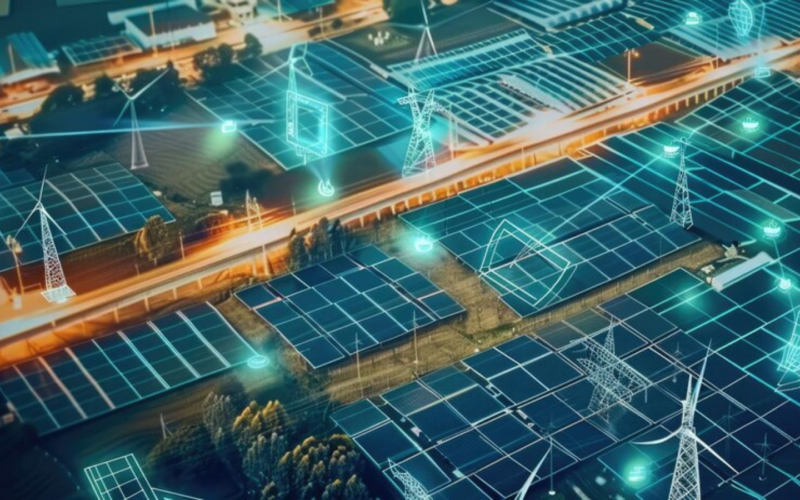Solar power has huge potential, but unpredictable output often leaves you scrambling. The U.S. Department of Energy recently awarded over $7 million to projects using AI and machine learning to make solar panels more reliable and feed the grid more efficiently.
You’ve probably wrestled with cloudy forecasts, surprise maintenance calls, or missed revenue when panels underperform.
In this article, you’ll see how AI in solar energy can sharpen your weather predictions, automate panel checks, and smooth out power flows.
Key Takeaways
- AI in solar energy helps businesses improve forecasting accuracy, automate maintenance, and optimize power flow decisions.
- Key steps include collecting clean panel and weather data, training output prediction models, simulating panel layouts, and integrating AI into daily operations.
- Challenges like unplanned downtime, poor yield, and missed grid bids can be reduced with real-time fault detection and smart energy dispatch.
- Future trends include agentic digital twins, AI-powered interconnection support, and edge-based automation at the panel level.
- Codewave helps solar businesses build and deploy custom AI solutions, backed by real data, faster timelines, and long-term impact.
Why Do Solar and AI Make a Good Pair?
Solar AI market in the U.S. is expected to see sustained double-digit growth, with the global Solar AI market forecast to reach $4.7 billion by 2033. You’ve dealt with panels underperforming after a cloudy week or surprise repair bills eating into your margins. By tapping into AI in solar energy, you feed live weather and panel data into models that flag trouble before it costs you.
Sunlight isn’t a polite business partner; it drifts, dims, and disappears without notice. The grid, your contracts, and your investors still expect steady output. Here’s where the gaps show up and how AI in solar energy can close them:
| Sunlight reality | Pain at your site | AI fix in one line |
| Clouds roll in mid-day | Revenue dips, grid buys spike | Forecast models reroute power plans fast |
| Dust or cracks cut panel yield | Hidden losses pile up | Computer vision flags dirty or damaged modules |
| Peaks at noon, demand at dusk | Battery cycles wear thin | Predictive control shifts charge, discharge timing |
| Tariffs change hourly | Missed high-price sell windows | Pricing engines pair output with best market slot |
| Crew visits on a fixed calendar | Costly downtime between checks | Health scores trigger just-in-time maintenance |
AI earns its keep by spotting patterns you’d miss in the daily noise of sun, dust, and price swings. Feed it weather maps, sensor logs, and market rates, and it turns chaos into a tidy schedule that keeps cash flowing.
Here’s how AI in solar energy closes the gaps:
- Predicts sunlight minute-by-minute so you can lock in bids with confidence
- Tracks subtle drops in panel output and flags trouble before yield slips too far
- Times battery cycles to hit demand peaks without frying storage life
- Maps tariff shifts against expected generation, steering power to the best-paying slot
Struggling to bring AI into your solar platform? Explore Codewave’s AI/ML Development services to build smarter forecasting, fault detection, and energy management systems. Let’s help you turn data into action.
Now that you know why AI belongs in your toolkit, let’s put it to work.
Forecasting, Panel Design & Site Planning
A dusty panel can slash output by 20 percent before anyone notices. With AI in solar energy, you see those drops in real time, send crews only where they’re needed, and move stored power when prices peak.
Let’s look at how AI cuts faults, trims upkeep, and boosts returns:
Step 1: Weather & Output Predictions
Get the sky right and the rest falls into place. Here’s how AI in solar energy turns changing clouds into steady cash flow:
- Train models on satellite, drone, and on-site sensor data so the system learns local sky habits.
- Convert those forecasts into hour-by-hour kWh curves your trading desk can lock into bids.
- Business win: fewer penalty fees and a smoother, more predictable revenue stream.
Step 2: AI-Driven Layout & Tilt Simulation
Space is money, so place every panel where it pulls its weight. Here’s how ai in solar energy turns site scans into higher output:
- Map rooftops or fields automatically with computer-vision and GIS tools to catch every ridge, tree line, and vent.
- Run season-long sunlight-angle simulations to pick tilt and row spacing that squeeze out the most watts per square foot.
- Business win: higher yield without buying more hardware.
Step 3: Linking Design to Dollars
Panels don’t pay the bills until the math adds up, so let ai in solar energy turn layouts into line items your finance team can trust:
- Compare “what-if” layouts by ROI and payback. Line up each design against your capex and O&M targets.
- Push the winner into your financial model so lenders and board members see firm numbers, not hunches.
- Business win: faster approvals and clear cash-flow forecasts.
Forecasts and layouts are just the start, now it’s about keeping panels running and power flowing.
Maintenance, Monitoring & Power Management
Once your system is live, every missed fault or mistimed battery cycle eats into margins. AI doesn’t just monitor, it acts. From spotting panel issues early to making real-time power flow decisions, it helps you keep operations tight and predictable.
1. Automated Fault Detection
Panel performance drops quietly, dirt, microcracks, hot spots rarely trigger alerts until the losses stack up. AI-powered computer vision changes that.
Using drone scans or fixed cameras, it continuously checks for faults and assigns severity scores. Whether it’s a minor temperature anomaly or a module-level shortfall, your team knows what’s wrong, where, and how urgent it is.
What you gain: faster diagnosis, reduced downtime, and fewer energy losses from unnoticed issues.
2. Predictive Crew Scheduling
Most teams rely on fixed calendars or user complaints to plan site visits. That’s reactive, and expensive.
AI models track sensor data like inverter temperature, vibration levels, and voltage fluctuations. These patterns are scored to predict likely failures.
Crews get dispatched only when needed, and with specifics on what to fix. No time wasted on routine checks or unnecessary field runs.
What you gain: lower O&M costs, higher crew efficiency, and fewer emergency fixes.
3. Smart Energy Flow
Storage isn’t cheap, and poor timing kills returns. AI monitors your live solar output, local consumption, and market prices, all at once.
It decides when to:
- Charge your batteries (when output is high and demand is low)
- Discharge to cover demand peaks
- Sell to the grid when tariffs make it worthwhile
This isn’t manual load balancing, it’s AI constantly calculating where your next unit of power earns the most.
What you gain: better use of stored energy, smarter grid exports, and stronger revenue from the same capacity.
Business Impact Metrics
Want to show the numbers? Start tracking:
- Uptime gains from earlier fault detection
- Maintenance cost per kWh saved through smarter crew dispatch
- ROI on battery investments based on optimized discharge cycles
Want to see how AI is shaping business and education? Check out this blog for real-life examples and practical use cases changing the way we work and learn.
Planning, maintenance, and power control are only as smart as the tools and data behind them. Let’s break down what you actually need to get started.
Getting Started with Tools & Data
Before AI can do its job, it needs clean, consistent input. And while solar data can be messy, spread across sensors, loggers, and spreadsheets, setting up a solid pipeline doesn’t have to be complex or costly.
Here’s how to build a strong starting point, even without a full in-house tech team.
1. Start with the Right Data
AI models are only as good as what you feed them. Focus on collecting:
- Panel-level performance data (voltage, current, temperature)
- Weather inputs (irradiance, wind speed, ambient temperature, cloud cover)
- Site metadata (tilt, azimuth, row spacing, location coordinates)
To keep it usable:
- Ensure timestamps are consistent across all devices
- Remove gaps and outliers before training your models
- Use centralized storage, cloud or local, so everything’s accessible from one place
Even if you’re starting small, clean data now saves you major headaches later.
2. Open-Source Libraries You Can Try Today
You don’t have to build everything from scratch. These libraries help you start modeling, forecasting, or scanning right away:
- pvlib (Python) – Great for simulating solar energy systems and irradiance modeling
- scikit-learn / XGBoost – Reliable for basic machine learning, including output prediction
- TensorFlow / PyTorch – Ideal for deeper models like fault detection or time-series forecasting
- OpenCV – Useful for image-based fault detection from drone or camera footage
You can test models on a subset of your data before scaling up, and adjust based on what actually improves performance.
Tips to Keep It Practical
- Start with just one model: output prediction, fault detection, or battery dispatch
- Use existing data first, then upgrade sensors if needed
- Set clear performance goals (e.g., reduce forecast error by 10%, cut unplanned maintenance by 20%)
You don’t need to overbuild. A lean setup that runs well beats a complex system no one checks.
Once the basics are in place, the real question is, where is all this headed? Let’s take a look at what’s next for AI and solar integration.
Future Trends in AI and Solar Integration
AI in solar energy isn’t standing still, it’s moving from basic monitoring to systems that think, predict, and act on their own. We’re seeing early signs of this shift in real-world pilots, backed by government funding and academic research.
From AI speeding up grid interconnections to agentic digital twins that plan ahead, the future is pointing toward smarter, more self-reliant operations.
Below are the key trends shaping what’s next for AI in solar energy:
1. Digital Twins That Learn and Act
Operators are now experimenting with full digital replicas of solar farms known as digital twins , systems that mimic real-world assets in software. One 2025 study shows how combining AI with twin models enables real-time performance tracking, simulated fault detection, and even corrective steps before trouble hits
2. Smart Edge AI at the Plant Level
Cloud servers aren’t always fast or reliable enough for farms spread across remote sites. The next wave brings AI embedded right at the panel or inverter, an “edge” layer that acts fast, stays private, and stays light on bandwidth. That means catch issues or reroute power in milliseconds, not minutes.
3. AIoT: Devices That Talk, Learn, and Decide
Sensors, cameras, batteries, and inverters will increasingly connect through the AI-powered Internet of Things. One 2025 analysis describes future systems where every node communicates, learns, and adjusts on its own. Your plant becomes a mesh of intelligent parts, each making small calls toward efficiency and savings.
4. AI to Speed Up Project Interconnection
Right now, projects can sit in limbo for years waiting to connect to the grid. The U.S. Department of Energy has launched the AI for Interconnection (AI4IX) program with $30 million in funding to change that. AI tools will scan applications, flag missing info, and guide developers through the process. For solar businesses, this means faster entry to the grid, smoother approvals, and less time watching panels idle.
5. AI-Driven Robotics for Autonomous Maintenance
Robots guided by AI now scan and clean solar panels without a human in sight. These drones and automated cleaners combine thermal imaging and computer vision to catch dirt, cracks, and hot spots early. That means fewer shutdowns and lower O&M costs on farms where scale makes manual upkeep slow and costly.
Struggling to design AI products that think and act on their own? Check out Codewave’s Agentic AI Product Design and Development services to build systems that reason, adapt, and respond in real time. Start building truly intelligent solutions today!
AI in solar energy isn’t just about automating tasks, it’s about making every decision sharper, faster, and more profitable. Start small, scale smart, and let the data do the heavy lifting.
Why Choose Codewave for AI Integration in Solar Applications?
Curious to see how Codewave can bring AI into your solar application? Explore our portfolio to see how we’ve helped businesses turn complex energy data into real-time decisions using smart, scalable AI solutions.
When you’re integrating AI into your solar platform, be it for forecasting, panel monitoring, or smart power management, you need more than just off-the-shelf models. At Codewave, we work closely with your team to build AI systems that align with your operations, scale with your growth, and deliver measurable impact.
What You Get with Codewave’s AI Integration for Solar Applications:
- 60% faster development of AI-powered features: Accelerate the integration of forecasting, fault detection, and smart dispatch, improving operational efficiency.
- 3x quicker deployment: Bring AI into your solar platform seamlessly and without delays, optimizing performance from day one.
- Save up to 3 weeks every month: Automate maintenance alerts, energy flow decisions, and data analysis, freeing up valuable time for your team.
- 25% lower development costs: Cut costs through lean, AI-driven workflows specifically designed to streamline processes in the solar industry.
Our Services for AI-Driven Solar Applications Include:
- AI Integration for Solar Platforms: We work closely with your team to understand operational needs and tailor AI solutions that scale with your solar assets.
- End-to-End AI Development: From system design to deployment, we build intelligent features like weather-output prediction, performance analytics, and predictive maintenance.
- Advanced AI Capabilities: Whether it’s computer vision for panel scans, battery optimization, or real-time demand matching, we bring in AI that works in the field, not just in theory.
- Data Dashboards & Optimization Tools: We help you track uptime, yield, and cost-per-kWh through smart dashboards, giving your ops and finance teams the clarity to make quick, data-backed decisions.
Curious to see what your data is really capable of? Book a free demo with Codewave’s experts and discover how we can turn your data into real results.
FAQs
Q. How can I ensure my AI model for solar forecasting stays accurate over time?
A. Forecast accuracy depends on keeping your models updated and your data clean.
- Retrain models frequently with the latest weather and output data.
- Monitor prediction errors and adjust for seasonality or site-specific quirks.
- Use hybrid models (combining physical and AI-based) for better long-term performance.
Q. What kind of data do I need to get started with AI in solar energy?
A. To start, focus on these key data types:
- Panel-level performance data (voltage, current, temperature)
- Weather data (irradiance, cloud cover, wind speed)
- Site metadata (panel tilt, azimuth, location)
Make sure it’s time-stamped, clean, and synced across sources. Even small-scale data can drive solid results when modeled right.
Q. How do I integrate AI into an existing solar monitoring system?
A. You don’t need to rebuild everything.
- Start by plugging AI into one use case, like fault detection or forecasting.
- Use open-source libraries like pvlib, scikit-learn, or OpenCV for quick pilots.
- Make sure your existing system allows API access or data export so AI models can work with what you already track.
Q. Will AI slow down my system or require heavy infrastructure?
A. Not if you architect it smartly.
- Run lightweight models on edge devices for fast fault detection.
- Offload heavier computations like forecasts to the cloud.
- Use lazy loading and batch predictions to reduce processing during peak hours.
Q. How can I measure ROI from AI integration in solar operations?
A. Track key impact areas like:
- Uptime improvement and fewer unexpected shutdowns
- Reduction in manual maintenance visits
- Higher yield from optimized layouts and storage decisions
- Faster project approvals due to clear forecasting and financial projections
Tie each improvement back to operational cost savings or increased energy revenue.
Q. How can I ensure data privacy and compliance when applying AI in solar?
A. Even though solar data isn’t always sensitive, if you’re collecting user, location, or financial data, here’s how to stay compliant:
- Encrypt all data at rest and in transit
- Anonymize any customer-specific information
- Follow regional data laws like GDPR, especially for residential or smart meter data
- Get explicit consent where needed
Codewave is a UX first design thinking & digital transformation services company, designing & engineering innovative mobile apps, cloud, & edge solutions.







